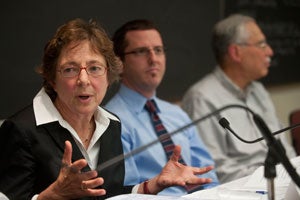There’s little argument that the landmark Supreme Court decision Brown v. Board of Education, which rejected as unconstitutional “separate but equal” segregated schools in Kansas, had an international impact. What remains in dispute is the exact nature of that impact and how it will reverberate into the future.
The continuing debate over Brown’s effects was forcefully illustrated on Tuesday, Sept. 28, by a panel discussion of Harvard Law School Dean Martha Minow’s new book, “In Brown’s Wake: Legacies of America’s Educational Landmark,” the first in a series of events on faculty-authored books sponsored by the Charles Hamilton Houston Institute for Race and Justice and HLS. Minow [photo below, right] was in attendance as four Harvard panelists presented their analysis and interpretation of her book.
Panelists praised the book for showing how Brown was both an important legal precedent and a cultural icon, affecting issues not only of race, but gender, social class and religion.
“Brown has never been about a condemnation of racially separated schooling just in order to get mixing, with no further ends,” said Professor Frank I. Michelman, summarizing one of Minow’s observations. “Rather, race-based segregation has been targeted as a contributing cause or enabling condition of certain harms or evils” he said. Segregation produced poor education for blacks, enforced racial hierarchies and prevented economic advances, litigants claimed.
“Notice how all of these claims say that segregation is bad or wrong in view of something else,” Michelman said. “That is quite different from saying that segregation is bad or wrong – period – just in the act of doing it.”
View video of the panel discussion.
But when Brown was handed down in 1954, Michelman—who was 17 at the time— viewed it differently. “I confess I did take it to speak for a sense that … discrimination on the basis of race is odious, repellent,” he said. Not because of what discrimination does but “odious in the very doing of it.”
Michael Gregory, assistant clinical professor of law, drew on the popular TV series “Lost” to explain the tension between two opposing but equally important sets of values for public education illustrated by the Brown decision. “Lost” characters who ricocheted through time developed nose bleeds because “the human brain is not made to exist simultaneously in two different time periods.”
Likewise, Gregory said, he gets a metaphorical nose bleed when he contrasts group and individual values in public education; that is, what we “expect our education system to do for our democratic society” versus “opportunities we hope and expect our education system to give every single child” – two equally important values often in conflict with each other.
Susan Cole, director of Harvard’s Education Law Clinic of the Trauma Learning Policy Initiative, said Minow has not only helped us understand how Brown knocked down legal barriers to equal education but has helped us “acknowledge our disappointment in its failure to achieve the inclusive integrated schools we hoped would emerge.”
Benjamin Sachs [photo left], assistant professor of law, was particularly struck by Minow’s use of a quote by Steve Adams: “Brown belongs not to the United States but to the world.” The book reveals “how many of us have a stake in Brown,” he said.
The case has also had economic ramifications, as post-Brown litigants have linked race and class differences, panelists observed. And yet, despite the enormous practical promise of such an approach, the book makes clear the multiple ways, both legal and political, in which attempts to address economic inequality in education have failed,” Sachs said.
Nevertheless, said Cole, the goal of Brown remains “the right one.”
“With this text in hand we have the tool we need to evaluate the legal strategy and fulfill Brown’s promise,” she said.
Minow expressed gratitude for the critique. “It’s nice to hear the positive words, but the challenges are even more meaningful to me,” she said.
— Stephanie Schorow
